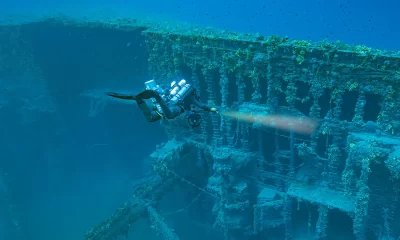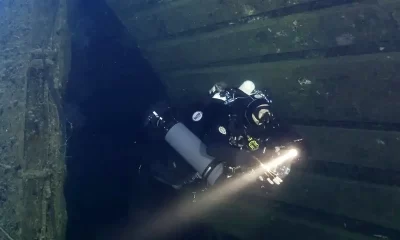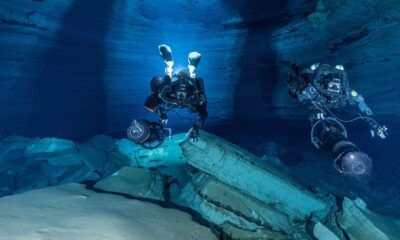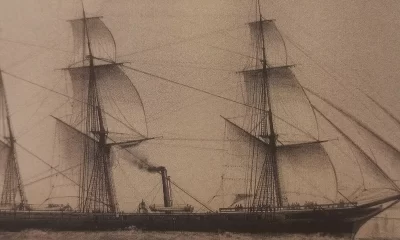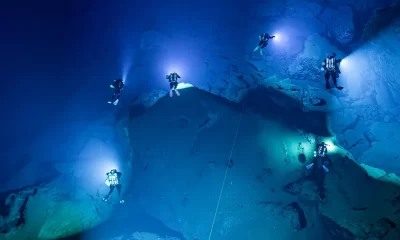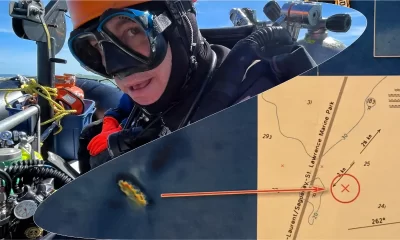Exploration
Sheng-loong Sinkhole: A Personal Perspective
By Chen Qian (Charlie). Photos courtesy of the author unless noted.

In May 2023, I suggested to Dr. Richard (Harry) Harris and Craig Challen that we could do a joint exploration at Daxing Spring; the intended dates for this exciting exploration were in January 2024. Later, Dave Hurst also joined the team, and we had been working on visa applications since September 2023. But, sadly, one deep cave diving accident happened at Daxing Spring in October when Craig, Harry, and Dave all received their visas to China, making our exploration very unpredictable because rumors kept circulating that Daxing Spring was going to be closed. Ever since then, I had been closely following up with the policies but eventually failed to get a permit for diving at Daxing Spring on the last day of 2023. On 31 December, I had to inform the team of the sad news and they had to cancel their tickets.
In early January 2024, I still thought we might have a chance of getting the permit after Chinese New Year. However, Harry’s and Dave’s schedules were both no longer available after March. Luckily, Craig was still willing to wait for further notice until the end of April, and his friend Andy Oakeley would join us as well. Meanwhile, I had been working on the possibility of getting the permit while driving to Daxing Spring to meet local friends for advice, but all those endeavors failed completely three days prior to Craig’s and Andy’s arrivals. Daxing Spring was officially off the table.
Frustrated, I immediately drove to Nanning city to meet local friends and apply for the permit to dive in our secret back-up site, a decent alternative to Daxing: Sheng-loong Sinkhole. With great help from local friends, authorities of Shenglongtan Park approved the permit—one day before Craig and Andy’s arrival. That was intense!
Exploration Commences
For me personally, the first week of exploration was tough. Because the on-site dive center was still under construction, everything we needed had to be built from the ground up. In order to make sure all things went smoothly, I spent five days organizing the logistics and coordinating among support personnel. Meanwhile, most Chinese support fellows were not deep divers and did not have experience in complicated exploration projects; so, it took me many days communicating with the whole team including support divers, land staff, and the RIB team.
After Craig and Andy completed two successful check out dives, I finally got the chance to do my first check out dive. Deep in my heart, I fully understood the unique experience would be a priceless treasure for all participants, from which people grew. But my personal rhythm of preparing for big dives was still disturbed, making me anxious and stressed. The way Craig and Andy prepared for their dives was very impressive: First, they finished their preparation for diving in a fast and solid manner. Second, they were very relaxed in every step, mentality-wise.



Everything got better when I finished my 232 m/761 ft dive to the bottom of the shot line. Passing depth 150 to 200 m/492 to 656 ft facing south, divers could see the shot line close to a wall of the gorge; this really made me think of Daxing Spring. But beneath 200 m, again, we descended without any natural visual reference. Reaching 220 m/722 ft facing north, divers could see an outcrop with a gentle cliff going down to 229 m/751 fr where the shot line ended. At the same time, I noticed my No.1 oxygen sensor was not working properly, so I spent only one minute at the bottom checking out surroundings and compass readings. The rest of the dive went smoothly. Three of us almost surfaced at the same time.
When I was diving at Daxing, normally I would take at least 3 days off after a sub-230 m dive. But I did realize time was luxury during a big exploration project because divers and support personnel could get bored or anxious if there were too many free days between dives. This was important, but I did not think it through before the project. Honestly speaking, I was not very much ready to do the 250 m/820 ft dive after the one-day break; on the only free day, I was busy with filling cylinders and taking care of logistics details without enough time to get rest. I should have communicated with the team to take one extra day off.

Hitting 250m
On April 7, we did a dive to 250 m/820 ft to check out the potential exploration breakthrough. Upon reaching the 229 m/751 ft shot line, Andy held it for a few minutes and returned while Craig and I ran a line to find the tunnel rumored to be deeper than 250 m. After five and half minutes of navigating, searching, and swimming, Craig and I found a wall of rock at 250 m when we were heading south. The slope towards the southeast seemed quite promising to extend further and deeper, but we were already one minute beyond the dive plan which was a bad idea because I had only one diving support team on that day.
Due to Chinese Memorial Day, many support members had to take a few days off for family ceremonies. A much longer bottom time meant I would miss the planned meet-up depth with my support divers or they would take higher risks to dive deeper than planned. Therefore, I made an even worse decision to meet them ASAP by ascending faster at a rate I never had before! According to my rebreather controller data, my average ascent rate from 220 m to 150 m was 33 m/108 ft per min. That was too fast. My previous ascent rate was always controlled between 23 and 28 m/75 and 92 ft per min. Probably relevant to the ascent, I had a stomach ache at 60 m/200 ft but it eased around 30 m/100 ft. A valuable lesson was learned from this incident that, obviously, a diver should not eat probiotics right before an über-deep dive. I didn’t know why I did it in the morning, but the excess gas produced by probiotics had clearly caused great hazard for me while ascending at high speed.
At 18 m/59 ft during decompression, I felt a warmth flowing through my right thigh; it confused me at that time, but now I understand that it was likely a sign of bubbles damaging neural cells, unluckily. The rest of decompression was surprisingly smooth, and I surfaced with a runtime of 523 minutes, a few minutes after “deco cleared.” I should have extended my decompression by at least another half hour. There was absolutely no point feeling sorry for the land support personnel staying up too late in the evening, because the safety consideration of diving matters more than anything. This is another valuable lesson: to discuss this possibility with everyone on the first day of exploration.
There are many afterthoughts to reflect upon. Besides communication within the team, a complicated project should have an operations manager: a non-diver that knows the majority of the team well enough to take care of all land matters. It was not that I didn’t want to have the person, but I never thought Daxing Spring would be actually off the table. Things were messed up for the first few days. I would definitely avoid this kind of situation on the next project.
All Chinese support members worked really hard, and I could see Craig and Andy were indeed impressed by them. Except one part: the “talking and talking” part which often made our Australian friends confused. Everyone surrounding them seemed in need of endless verbal communication before executing a task, mumbling in elusive Mandarin Chinese. The talking part actually came from the fact that, in Chinese technical diving history, there hadn’t been any other event involving renowned foreigner explorers and Chinese explorers to work on the same exploration project.
Unfamiliarity made support members nervous about how well they had been performing, so talking with the general coordinator (in this case, me) could make most people reassured and confident. There were many situations where lots of talking was involved, including finding the perfect spot for a descent shot line and discussing support details for our final deep dive.

Deco Woes
After my long decompression was finished, I made another mistake by not staying at the surface long enough. After taking my gear to the platform, I only stayed in the water for less than 20 minutes. Walking up long stairs with my drysuit on suddenly enervated me. Dizzy and spinning, I immediately realized extra rest without physical exertion was imperative. Later in the evening while resting in my room, I felt numbness in my thigh and increasing fatigue. In hindsight, the best solution would have been immediate In-Water Recompression (IWR) when I felt the strong dizziness when climbing up the stairs. Why didn’t I? Because it was already midnight when I got back to my room, and going back to Shenglongtan Park to do IWR without official support was unrealistic. So I waited until the next morning to do it. On both April 8 and 9, I did IWR and, after each day, the somatic sensation of my right thigh was improving.
When I thought about my stomach ache during decompression around 60 m on April 7, I wondered if some mild neural damage was already done. Three things could be done in a better way: First, with the fact that very limited support divers were available due to national holiday, a different approach of exchanging bailout cylinders should have been considered. Second, my ascent rate should not have been affected by the worries of meeting support divers in a timely fashion. Third, when I felt the pain in my stomach, the possibility of going back to a deeper stop for extra time should have been immediately evaluated. During those days off, Craig and Andy together with support divers built an amazing habitat at 6.5 m/21 ft for the safety of our final exploration day.

After two days of IWR, the original plan forApril 11 was to dive along the shot line, swim towards the reel at 250 m/820 ft, and pick it up to continue exploring the southeast section of the area. Andy planned to swim with us until 240 m/787 ft, then return. The secondary goal would be to search for the rumored deep tunnel between 250 m and 265 m. Then, we would look for a projection to tie off the reel and ascend right away facing the rock wall, trying to determine whether we were in a cave/cavern.
I didn’t know right after the national memorial holiday there was another grand holiday only celebrated locally in this municipality. Therefore, very few support members were on site both April 9 and 10. It took me extra time to organize logistics, and my emotional tension was still intense because I had been coordinating with so many parties. I didn’t sleep well on April 9 and 10,and the RIB motor was stolen by a thief; the logistics team was, as a result, unexpectedly stressed because a new motor had to be borrowed soon in order to make the project safer.
What’s more, due to a preliminary agreement with friends, some new faces joined in after April 7. Lots of talking had to be done again, incurring excessive stress. On April 11, the original dive day for this 250 m+ exploration, emotionally distressed, I was caught in the middle between our Australian friends’ wish to dive earlier and Chinese friends’ desire to talk about more details before entering water (and, so, diving later). Meanwhile, a new borrowed RIB motor by Wolf was delayed for one hour in heavy morning traffic, and some support members also arrived later than planned. But the deep dive team was already ready to go with gear ready. We should have had a sophisticated operations manager!
The first rule of team diving is that anyone can call the dive at any time for any reason.* I’ve been thinking of this golden rule for a long time. When I was at Daxing, honoring it was very easy. There were many times I decided to push off an exploration date merely because something didn’t feel right. But I did find it much much harder to honor the rule when there were so many support personnel around me and a deep diving team waiting for me to get ready to dive.
All the talking and logistic work of the past few days had bought me significant anxieties. I knew the fact but had been secretly fighting it for a while, a bit obsessed with being afraid to let my friends Andy and Craig down. All those emotions peaked at 9:00 am on April 11; deep support diver Bai was asking me to talk more details about various emergency plans and Andy and Craig had been waiting near the stairs to don their drysuits, all while I was calling the RIB team to find out what time they could arrive with the new motor.
Finally, Craig and Andy saw my stress and kindly asked me if it would be better to call the dive. That was a huge relief for me! Coincidentally I was also thinking how to tell the whole big team that I was not ready to dive today. All support members were surprisingly happy because they didn’t think they were ready either. That was absolutely the best decision. For the rest of the day, we took everything back to our prep rooms and spent hours talking through the emergency plans one by one and the procedure for getting Craig and me safely into the habitat. Everybody looked relieved.

Because my backup plan was OC-based, the support team was extremely important for carrying deco cylinders to me. I should have worked out a better plan with stage/deco cylinders hanging at different depths on the shot line instead of having support divers carrying tanks every dive. My logistics team had little experience in a complicated deep cave project, and exploration in Sheng-loong Sinkhole took place almost on the spur of the moment, in spite of sophisticated, advance preparation. Acting as both operations manager and a deep cave diver was a mistake: an explorer should have enough space for himself. Luckily, all friends were very kind to understand my situation, so we pushed one more day off.
Physiology Watch
April 12 was a very nice day! Everyone else was back from the local holiday and the dive itself was also good. Except when Craig and I spent a bloody eleven minutes swimming below 230 m/754 ft! After we retrieved the reel, we started the epic swim toward the southeast, and with a bit of disappointment we found out the slope wasn’t as steep as we thought. We wished we had Seacraft scooters to ride beyond 252 m/827 ft. During decompression at 120 m/394 ft I felt my stomach ache again. The seven hours of deco hereafter before entering the habitat were literally a mental fight against that stomach ache, like a pain endurance marathon.
This was my first time utilizing a decompression habitat on an über-deep dive, and the experience was just incredibly amazing! My stomach ache vanished immediately after I entered the habitat, like a magic! I guess it was mainly because of the water pressure on my belly causing the pain, probably because my digestive system wasn’t ready before the dive. For extra safety, I stayed in the habitat for an additional two hours after Craig finished his dive. Twelve and half hours passed, and I returned to the surface better than before. Cheers.


Some additional thoughts of this exploration.
The HPNS symptoms:

Two different back-up options:
Craig and Andy were using their dual-rebreathers and I was using a single rebreather with open circuit gas back up. Based on past experience, I was satisfied with my configuration and felt safe about it. But the disadvantages of my choice were also non-negligible. Watching Andy using his ‘QJ’ (Dual-JJ: JJJJ) gave me some insights into this new consideration and obviously Craig had been happy with his dual-meg system for more than a decade. It’s definitely an interesting topic to think about in the future.


The ‘NDA’
I had all support personnel sign a non-disclosure agreement before the exploration. The accident at Daxing Spring in 2023 had caused unimaginable damage to the Chinese technical diving community as a whole. Nationwide escalation of restrictions or prohibitions towards scuba diving had been growing ever since the accident, and it became a trending topic in national media. Therefore, the park authorities’ request for an NDA coincidentally matched my personal wishes: 100% efforts dedicated to exploration diving itself with the less interference from outside the better. In fact, all extreme deep diving is a purity test for explorers’ mentality.
The friendship between Australian explorers and Chinese team: A warm and profound relationship was established among both sides. All Chinese friends gained transnational friendship, exploration experience, and personal confidence. This exploration project was a symbol of friendship among Australian and Chinese deep cave diving explorers, and I believe more genuine sharing of this experience will help the community grow. This might also raise a hope for returning to Daxing Spring in the future. Who knows? We get to try and try, and we never give up easily. Fingers crossed!
Return to Deep in Sheng-loong Sink
DIVE DEEPER
InDEPTH: My Personal Experiences with HPNS on Five Sub-200 meter Dives by Chen Qian aka Charlie
InDEPTH: Introducing World Underwater Discovery – China’s Homegrown Tech Agency Interview with WUD cofounder and president Yuan Wang by Michael Menduno.
InDEPTH: Homegrown Chinese Tech

Thirty-three year-old Chen Qian (Charlie) is a passionate deep cave explorer who has spent three years in DaXing Spring, China, testing different deep diving techniques and deco approaches. So far, he has done eight 210+ meter explorations into deep caves, including his 258 m/846 ft dive at the South Tunnel of DaXing, which was previously explored to 213 m/699 ft by WetMules Dr. Richard Harris and Craig Challen in 2015. In April 2024, Craig Challen and Andy Oakeley joined Chen Qian in Nanning, China to explore the mysterious Sheng-loong Sinkhole. He and Craig made two 250 m+ dives into the deep underwater cave of Sheng-loong Sinkhole, where the cave entrance started at 230 m. His recent dream is to join in more cave explorations in different countries and to make new friends with other elite explorers. He can be reached at: kind1412333@me.com.




















